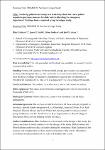Involving patients and caregivers to develop items for a new patient reported experience measure for older adults attending the emergency department. Findings from a nominal group technique study
| dc.contributor.author | Graham, B | |
| dc.contributor.author | Smith, J | |
| dc.contributor.author | Barham, F | |
| dc.contributor.author | Latour, J | |
| dc.date.accessioned | 2023-06-22T06:25:01Z | |
| dc.date.available | 2023-06-22T06:25:01Z | |
| dc.date.issued | 2023-06-30 | |
| dc.identifier.issn | 1369-7625 | |
| dc.identifier.issn | 1369-7625 | |
| dc.identifier.uri | https://pearl.plymouth.ac.uk/handle/10026.1/20991 | |
| dc.description.abstract |
CONTEXT: Patient experience is an important component of high-quality care and is linked to improved clinical outcomes across a range of different conditions. Patient-reported experience measures (PREMs) are psychometrically validated instruments designed to identify where strengths and vulnerabilities in care exist. Currently, there is no validated instrument available to measure patient experience among people aged over 65 years attending the emergency department (ED). OBJECTIVE: This paper aims to describe the process of generating, refining and prioritising candidate items for inclusion in a new PREM measuring older adults' experiences in ED (PREM-ED 65). DESIGN: One hundred and thirty-six draft items were generated via a systematic review, interviews with patients and focus groups with ED staff exploring older adults' experiences in the ED. A 1-day multiple stakeholder workshop was then convened to refine and prioritise these items. The workshop entailed a modified nominal groups technique exercise comprised of three discrete parts-(i) item familiarisation and comprehension assessment, (ii) initial voting and (iii) final adjudication. SETTING AND PARTICIPANTS: Twenty-nine participants attended the stakeholder workshop, conducted in a nonhealthcare setting (Buckfast Abbey). The average age of participants was 65.6 years. Self-reported prior experiences of emergency care among the participants included attending the ED as a patient (n = 16, 55.2%); accompanying person (n = 11, 37.9%) and/or as a healthcare provider (n = 7, 24.1%). RESULTS: Participants were allocated time to familiarise themselves with the draft items, suggest any improvements to the item structure or content, and suggest new items. Two additional items were proposed by participants, yielding a total of 138 items for prioritisation. Initial prioritisation deemed most items 'critically important' (priority 7-9 out of 9, n = 104, 75.4%). Of these, 70 items demonstrated suitable inter-rater agreement (mean average deviation from the median < 1.04) and were recommended for automatic inclusion. Participants then undertook final adjudication to include or exclude the remaining items, using forced choice voting. A further 29 items were included. Thirty-nine items did not meet the criteria for inclusion. CONCLUSIONS: This study has generated a list of 99 prioritised candidate items for inclusion in the draft PREM-ED 65 instrument. These items highlight areas of patient experience that are particularly important to older adults accessing emergency care. This may be of direct interest to those looking to improve the patient experience for older adults in the ED. For the final stage of development, psychometric validation amongst a real-world population of ED patients is now planned. PATIENT AND PUBLIC CONTRIBUTION: Initial item generation was informed using qualitative research, including interviews with patients in the ED. The opinions of patients and members of the public were integral to achieving outcomes from the prioritisation meeting. The lay chair of the Royal College of Emergency Medicine participated in the meeting and reviewed the results of this study. | |
| dc.format.extent | 2040-2049 | |
| dc.format.medium | Print-Electronic | |
| dc.language | en | |
| dc.publisher | Wiley Open Access | |
| dc.subject | consensus | |
| dc.subject | emergency department | |
| dc.subject | nominal groups | |
| dc.subject | patient experience | |
| dc.title | Involving patients and caregivers to develop items for a new patient reported experience measure for older adults attending the emergency department. Findings from a nominal group technique study | |
| dc.type | journal-article | |
| dc.type | Article | |
| plymouth.author-url | https://www.ncbi.nlm.nih.gov/pubmed/37391897 | |
| plymouth.issue | 5 | |
| plymouth.volume | 26 | |
| plymouth.publisher-url | http://dx.doi.org/10.1111/hex.13811 | |
| plymouth.publication-status | Published | |
| plymouth.journal | Health Expectations | |
| dc.identifier.doi | 10.1111/hex.13811 | |
| plymouth.organisational-group | |Plymouth | |
| plymouth.organisational-group | |Plymouth|Research Groups | |
| plymouth.organisational-group | |Plymouth|Faculty of Health | |
| plymouth.organisational-group | |Plymouth|Faculty of Health|School of Nursing and Midwifery | |
| plymouth.organisational-group | |Plymouth|Research Groups|Institute of Health and Community | |
| plymouth.organisational-group | |Plymouth|REF 2021 Researchers by UoA | |
| plymouth.organisational-group | |Plymouth|Users by role | |
| plymouth.organisational-group | |Plymouth|Users by role|Academics | |
| plymouth.organisational-group | |Plymouth|REF 2021 Researchers by UoA|UoA03 Allied Health Professions, Dentistry, Nursing and Pharmacy | |
| plymouth.organisational-group | |Plymouth|Research Groups|Plymouth Institute of Health and Care Research (PIHR) | |
| dc.publisher.place | England | |
| dcterms.dateAccepted | 2023-06-19 | |
| dc.date.updated | 2023-06-22T06:25:01Z | |
| dc.rights.embargodate | 2023-7-20 | |
| dc.identifier.eissn | 1369-7625 | |
| dc.rights.embargoperiod | forever | |
| rioxxterms.versionofrecord | 10.1111/hex.13811 |


